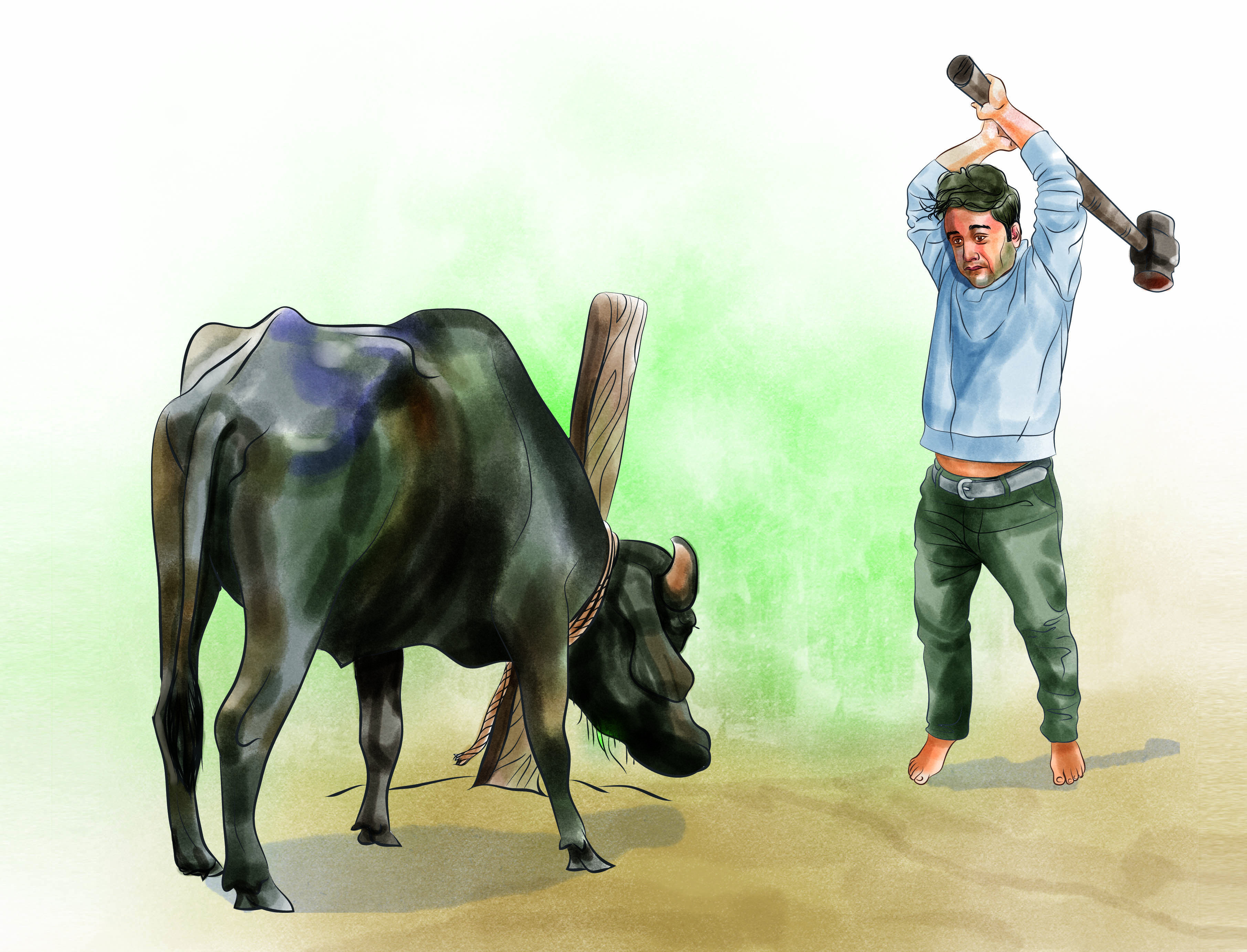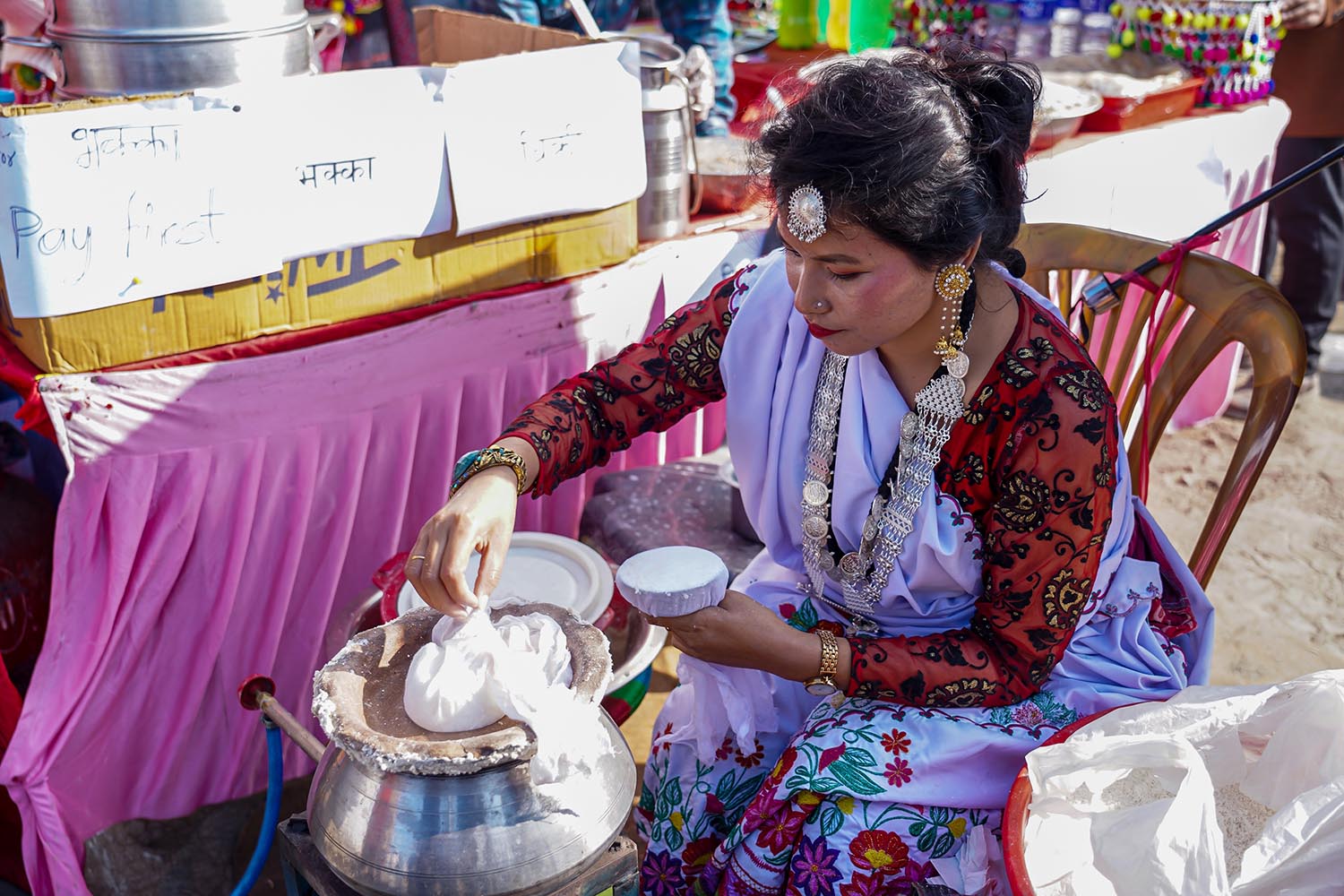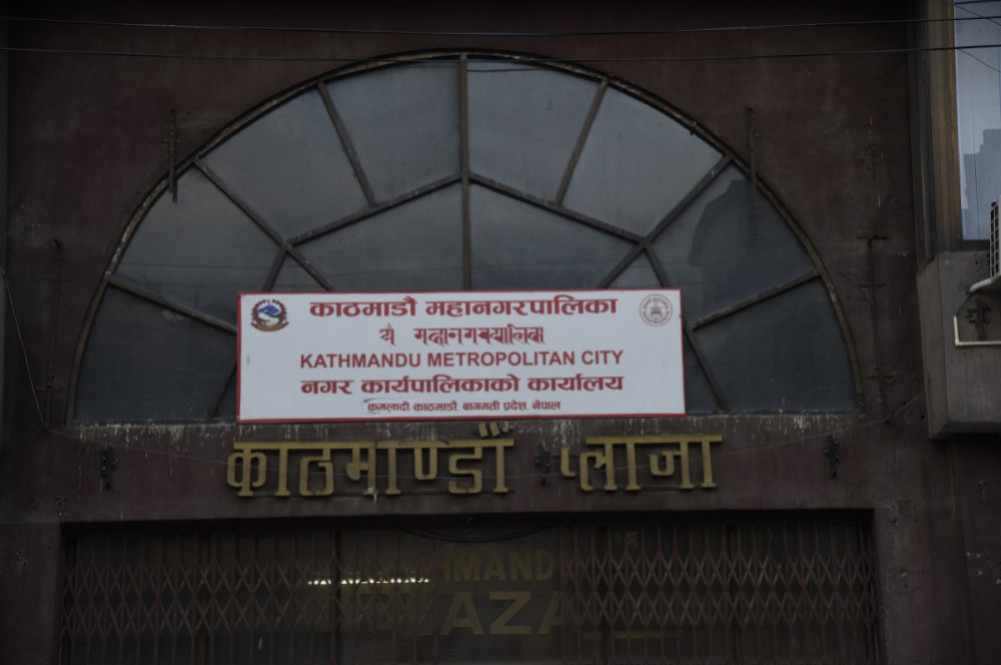Food
Butchering buffaloes is inhumane and unhygienic. But the government can’t do anything about it.
Even though the government set regulations and standards in 1999, inadequate implementation and poor regulation of the transport of livestock and their slaughter have left both animals and consumers unprotected.
Thomas Heaton
Skin and bones are scattered feet away from buffaloes awaiting slaughter. Mud, blood and entrails form a slurry on the killing floor.
Having arrived from the southern plains, packed by the dozen onto the beds of trucks, these bovines are pulled off and corralled. They are then pummelled to death with sledgehammers, before being skinned and eviscerated—the half-digested feed emptied from their stomachs into overflowing drains.
Splashes of blood and mud dry on slaughterhouse walls, while the stench of urine and faeces permeates the air.
In Kathmandu’s slaughter spots alongside the Bishnumati River, workers use the muddied animal hides as work surfaces and hammer at flesh and bones with blunt cleavers. The meat is dropped into dirty baskets for weighing before being loaded into pickup trucks, taxis and vans. By sunrise, just bones remain and meat sits ready for sale to the public at butchers.
Every day, about 200 buffaloes are killed in Teku and Jhochhen alone, in around 20 slaughter places—some spots are mere slabs of stone, others plots of concrete. Just about every directive under the Animal Slaughterhouse and Meat Inspection Act 1999 is ignored.
Distributed throughout the city to satisfy Kathmandu’s ever-increasing appetite, buffalo meat appears on the vast majority of restaurant menus, and in daily cuisine. Traditionally used for drafting and milk, and for their hides and meat, buffaloes have long held cultural and religious significance for many ethnic groups in the Kathmandu Valley. Buffalo sacrifice is conducted throughout the year in religious ceremonies, and the meat is closely associated with Newar cuisine—there are at least a hundred recipes using the animal’s flesh, its innards, brain, eyes, blood and tongue. And it is finding its way into more and more dishes.
As the demand for buffalo meat rises in the valley, the number of local buffaloes has decreased, causing the animals to be imported from outside the Valley and from India—61,000 buffaloes were imported from India last year, according to Nepal’s Livestock Department. Last year, Nepal’s annual per capita meat consumption reached 12 kilograms, up from 9.8 kg in 2008, and buff was the most popular choice of meat.
Most buffaloes are brought into Kathmandu Valley through Thankot, with 60 to 70 percent being brought in from India. From Thankot, they are dispatched to various spots around Kathmandu for slaughter.
However, despite regulations and standards set by the government in 1999, inadequate implementation and poor regulation of the transport of livestock and their slaughter have left both animals and consumers unprotected.
 Buffaloes are crammed into trucks with their noses and tails cinched and tied to the vehicle’s overhead frame. [Photo via Sneha Cares]
Buffaloes are crammed into trucks with their noses and tails cinched and tied to the vehicle’s overhead frame. [Photo via Sneha Cares]Like sardines in a can
Just last year, in response to a petition filed by advocates Padam Bahadur Shrestha and Shatkon Shrestha, the Supreme Court issued an interim order asking the government to ensure that livestock are transported humanely. The Court also directed the government to implement its Animal Transportation Standards 2008, which limits the number of buffaloes to 15 per truck, and mandates that livestock not be transported for more than eight hours without rest, feed and water. Buffaloes must also have a minimum of 1.25 metres to move and breathe.
Despite the government’s standards, buffaloes continue to be transported by the hundreds to the Kathmandu Valley every day. They are crammed into trucks that are woefully inadequate, their noses and tails cinched and tied to the vehicle’s overhead frame. It takes between eight to ten hours to get to the Valley from around Birgunj—without rest, water or feed.
“The trucks used are not suitable for animal transportation,” says Pramada Shah, president of Animal Nepal, an animal welfare organisation. “There are no ramps so they throw the buffaloes into the trucks. They are not allowed to rest and if something goes wrong on the highway, they’re stuck there for an extra hour, two hours, an entire day, without water or rest.”
In a National Livestock Welfare Survey, conducted by Animal Nepal in December 2018, the majority of livestock workers said they were unaware of any national standards or restrictions on the manner in which animals were transported.
A Hetauda-based livestock transportation worker who spoke to the Post said they try to take the animals to their destination as quickly as possible because there is no possibility to feed them grass and water on the way. “It takes about 8 to 10 hours to reach Kathmandu from Jitpur, unless there is a traffic jam,” said Baikuntha Balami. “We only provide grass and water immediately before they are loaded on the truck.”
From the government’s side, there have been more attempts at securing animal rights. Mistreatment of animals was criminalised in 2016, under the new Criminal Code. Those who abuse animals—from physical abuse and overworking to non-religious public killing—are subject to either three months in prison or a Rs 5,000 fine, or both.
But even government officials admit that the laws are inadequate.
The laws are currently ineffective and the aforementioned fines are too low, said Samjhana Kumari Kafle, deputy director of the Livestock Department at the Ministry of Agriculture. This has led livestock workers to knowingly break the law, expecting to pay just meager amounts in recompense, she said.
But the fines can rack up, even before the buffaloes enter Nepal. Buffaloes destined for the Capital must first go to one of 21 quarantine offices. If they don’t, they are liable for a fine of Rs 5,000. Still, many skip quarantine and checkpoints while others untie their animals for the checkpoint, retying them afterwards. Still other trucks pick up more buffaloes along the highway, says Kafle.
Trucks and their contents are checked at three checkpoints on the East-West Highway, against certificates issued at the quarantine office. Police are able to do random checks too. Even if found breaching the law, many get away scot-free.
“Everything is documented, everyone knows, but some traders just don’t follow the rules,” Kafle says. “They just keep a fine ready in their pocket.”
The problem, however, lies not just in enforcing laws and regulating transport. There is a fundamental problem with the mentality of the transport entrepreneurs, who value commerce over the welfare of their cargo, says Lekhnath Poudel, Nepal representative for the World Organisation for Animal Health.
“Convincing people to reduce the number of animals being trucked from the border to the capital is a hard ask,” says Poudel. “The mentality is ‘if I’m carrying 20 animals and making a profit, why would I reduce that to ten? I’m paying the same transportation costs’.”
Kafle blames the lack of legal enforcement on the recent transition to federalism, despite the fact that the laws existed long before the new governmental structure. The fines are also so low because the laws are dated. Under the federal system, local governments are now responsible for enforcing the Animal Slaughterhouse and Meat Inspection Act 1999, Animal Health and Livestock Services Rules 2000 and Animal Transportation Standards 2008.
“Everything is written in detail, but it is not followed. We are very hopeful that local governments will prepare their own regulations, following our minimum standards, and make them even better than ours,” says Kafle.
The situation, however, has improved somewhat over the past five years, says Poudel. Quarantine papers were rarely inspected in the past, but the Ministry for Livestock Development now has two officers in Thankot to inspect trucks. There is an ongoing process to turn their posting into a permanent outpost.
The Livestock Department also has plans to standardise the trucks used for livestock transport. It is in touch with Chinese and Indian companies to create a standard design, which will be subsidised by the government, says Kafle.
Kafle is insistent that all stakeholders need to be responsible and work towards maintaining quality and following protocol to ensure proper production. “We are the technical people, we prepare the standards, but every system has to be followed at the local government level,” she says.
Under proposed amendments filed under the various animal welfare regulations, Kafle says punishment will be stricter, with fines up to Rs 100,000 and provisions for vehicle confiscation. The proposed amendments were submitted to the Ministry of Agriculture and Livestock Development a month ago, but have yet to be approved before being forwarded to Parliament.
 Buffalo meat is so popular that tens of thousands of animals are imported from India every year. [Photo: Shutterstock]
Buffalo meat is so popular that tens of thousands of animals are imported from India every year. [Photo: Shutterstock]The killing blow
There are no laws stating in which way buffaloes should be slaughtered or what slaughter is typically initiated with a blow to the head using a sledgehammer. Australia’s live cattle industry made international headlines in 2016, when it was revealed that similar slaughter methods were being used on its cattle exports in Vietnam’s abattoirs.
While none of the places of slaughter in Kathmandu can be classified as slaughterhouses, there are “slaughter slabs” throughout the city. Animals must be inspected before slaughter, and their meat and offal must also be examined. The resulting meat products must then have a “visible stamp or mark as prescribed at the time of giving permission for the sale of meat”, according to the Animal Slaughterhouse and Meat Inspection Act 1999. The Act states that those selling tainted meat, or meat from an already dead animal, will be fined Rs 10,000 in the first instance and face up to three months imprisonment or a Rs 20,000 fine for repeat offences.
Livestock and meat inspections, along with the officers who conduct the inspections, all has to be done by the local government, says Kafle. “Enactment has to come from local-level governments, but if they ask for technical support, that we can provide.”
Local-level governments should be monitoring transport, slaughter methods, sanitation standards, and livestock and meat health.
Past attempts at instituting proper slaughterhouses have been unsuccessful. One attempt, in Hetauda by the Danish government in 2003, collapsed as shipping meat to the Valley was too expensive, and consumers were not used to the chilled meat.
Kathmandu Metropolitan City (KMC) has acknowledged its need for abattoirs but has, however, failed to put anything substantial in place. In 2016, Republica reported that KMC would ban the slaughter of buffaloes in the valley. But buffaloes continue to be slaughtered in the valley. In 2017, KMC pledged to “strictly monitor” valley slaughter slabs, too. Again, that is not happening. The central government, however, did shut down four places of slaughter in Lalitpur last year.
KMC’s first attempt to build a slaughterhouse was more than five years ago, according to KMC City Health Division Director Nagendra Bilash Bajracharya.
The project accrued Rs 50.7 million in funding from central and local governments, but communities in the 13 selected plots did not accept it and the government took back its funding.
“The local community did not give us permission because they have traditional slaughter styles. But we tried to abide by the law and they didn’t agree,” says Bajracharya.
The city official said they were also having a hard time finding land for a slaughterhouse. “We just can’t afford it,” Bajracharya says. “All our opportunities are outside the valley.”
The only alternative, according to him, is building a facility in either Thankot or Naubise.
“Of course, it’s a concern for people because they want fresh meat. If we establish a slaughterhouse in Thankot, we can achieve that,” says Bajracharya.
The slaughter slabs found around Kathmandu are not up to standard, so if people want meat produced in sanitary circumstances, Thankot is the closest and best option, he says.
“I cannot say the current places of slaughter are hygienic,” he admitted. “The way in which they function makes them that way.”
Moving meat forward
For Animal Nepal’s Pramada Shah, Kathmandu is well aware of all these issues with their meat, but people are apathetic. Shah wants Animal Nepal to work in conjunction with the government to implement its own laws. The laws are a good start, on paper, but needed to be followed, she says.
“Ninety-nine percent of slaughter in Nepal is inhumane. We have to live with that fact,” says Shah. “But we want to make sure that the people working with buffaloes are taking responsibility.” If Animal Nepal had its way, it would like people to stop eating meat altogether. But they have had to accept that people enjoy meat. So they are focusing on major interventions.
“We need to implement the transport act, or we need to stop live transportation,” says Shah.
But buff is the most popular meat in Nepal, and the demand is for fresh meat. Animal Nepal’s survey found that consumer’s priorities were freshness, followed only then by hygiene, price, and quality.
“What kind of meat are we feeding our children? Consumers need to know what is in the meat,” says Shah.
The Livestock Department’s draft amendments to the various bills regarding livestock transportation, slaughter and meat distribution have been submitted, although whether they will be implemented and enforced is another question.
“We should not be optimistic,” Kafle, the deputy director general says. “Everyone is still confused as to how they should be working in the new federal system. It may be a few months for even that to happen.”




 10.12°C Kathmandu
10.12°C Kathmandu





